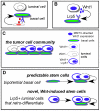Differentiation generates paracrine cell pairs that maintain basaloid mouse mammary tumors: proof of concept
- PMID: 21541292
- PMCID: PMC3082567
- DOI: 10.1371/journal.pone.0019310
Differentiation generates paracrine cell pairs that maintain basaloid mouse mammary tumors: proof of concept
Abstract
There is a paradox offered up by the cancer stem cell hypothesis. How are the mixed populations that are characteristic of heterogeneous solid tumors maintained at constant proportion, given their high, and different, mitotic indices? In this study, we evaluate a well-characterized mouse model of human basaloid tumors (induced by the oncogene Wnt1), which comprise mixed populations of mammary epithelial cells resembling their normal basal and luminal counterparts. We show that these cell types are substantially inter-dependent, since the MMTV LTR drives expression of Wnt1 ligand in luminal cells, whereas the functional Wnt1-responsive receptor (Lrp5) is expressed by basal cells, and both molecules are necessary for tumor growth. There is a robust tumor initiating activity (tumor stem cell) in the basal cell population, which is associated with the ability to differentiate into luminal and basal cells, to regenerate the oncogenic paracrine signaling cell pair. However, we found an additional tumor stem cell activity in the luminal cell population. Knowing that tumors depend upon Wnt1-Lrp5, we hypothesized that this stem cell must express Lrp5, and found that indeed, all the stem cell activity could be retrieved from the Lrp5-positive cell population. Interestingly, this reflects post-transcriptional acquisition of Lrp5 protein expression in luminal cells. Furthermore, this plasticity of molecular expression is reflected in plasticity of cell fate determination. Thus, in vitro, Wnt1-expressing luminal cells retro-differentiate to basal cell types, and in vivo, tumors initiated with pure luminal cells reconstitute a robust basal cell subpopulation that is indistinguishable from the populations initiated by pure basal cells. We propose this is an important proof of concept, demonstrating that bipotential tumor stem cells are essential in tumors where oncogenic ligand-receptor pairs are separated into different cell types, and suggesting that Wnt-induced molecular and fate plasticity can close paracrine loops that are usually separated into distinct cell types.
Conflict of interest statement
Figures





Similar articles
-
The Wnt signaling receptor Lrp5 is required for mammary ductal stem cell activity and Wnt1-induced tumorigenesis.J Biol Chem. 2006 Nov 17;281(46):35081-7. doi: 10.1074/jbc.M607571200. Epub 2006 Sep 13. J Biol Chem. 2006. PMID: 16973609
-
MMTV-Wnt1 and -DeltaN89beta-catenin induce canonical signaling in distinct progenitors and differentially activate Hedgehog signaling within mammary tumors.PLoS One. 2009;4(2):e4537. doi: 10.1371/journal.pone.0004537. Epub 2009 Feb 19. PLoS One. 2009. PMID: 19225568 Free PMC article.
-
Cooperative signaling between Wnt1 and integrin-linked kinase induces accelerated breast tumor development.Breast Cancer Res. 2010;12(3):R38. doi: 10.1186/bcr2592. Epub 2010 Jun 21. Breast Cancer Res. 2010. PMID: 20565980 Free PMC article.
-
Wnt signaling, stem cells, and the cellular origin of breast cancer.Stem Cell Rev. 2007 Jun;3(2):157-68. doi: 10.1007/s12015-007-0025-3. Stem Cell Rev. 2007. PMID: 17873348 Review.
-
Stem cells and mammary cancer in mice.Stem Cell Rev. 2005;1(3):215-23. doi: 10.1385/SCR:1:3:215. Stem Cell Rev. 2005. PMID: 17142858 Review.
Cited by
-
ROCK1 inhibition promotes the self-renewal of a novel mouse mammary cancer stem cell.Stem Cells. 2013 Jan;31(1):12-22. doi: 10.1002/stem.1224. Stem Cells. 2013. PMID: 22961723 Free PMC article.
-
IGF1R inhibition in mammary epithelia promotes canonical Wnt signaling and Wnt1-driven tumors.Cancer Res. 2014 Oct 1;74(19):5668-79. doi: 10.1158/0008-5472.CAN-14-0970. Epub 2014 Aug 4. Cancer Res. 2014. PMID: 25092896 Free PMC article.
-
Chromatin effector Pygo2 regulates mammary tumor initiation and heterogeneity in MMTV-Wnt1 mice.Oncogene. 2014 Jan 30;33(5):632-42. doi: 10.1038/onc.2012.620. Epub 2013 Jan 21. Oncogene. 2014. PMID: 23334328 Free PMC article.
-
Both LRP5 and LRP6 receptors are required to respond to physiological Wnt ligands in mammary epithelial cells and fibroblasts.J Biol Chem. 2012 May 11;287(20):16454-66. doi: 10.1074/jbc.M112.362137. Epub 2012 Mar 20. J Biol Chem. 2012. PMID: 22433869 Free PMC article.
-
Mix and Match: Phenotypic Coexistence as a Key Facilitator of Cancer Invasion.Bull Math Biol. 2020 Jan 17;82(1):15. doi: 10.1007/s11538-019-00675-0. Bull Math Biol. 2020. PMID: 31953602 Free PMC article.
References
-
- Wicha MS, Liu S, Dontu G. Cancer stem cells: an old idea–a paradigm shift. Cancer Res. 2006;66:1883–1890; discussion 1895–1886. - PubMed
-
- Carey LA, Dees EC, Sawyer L, Gatti L, Moore DT, et al. The triple negative paradox: primary tumor chemosensitivity of breast cancer subtypes. Clin Cancer Res. 2007;13:2329–2334. - PubMed
-
- Badve S, Dabbs DJ, Schnitt SJ, Baehner FL, Decker T, et al. Basal-like and triple-negative breast cancers: a critical review with an emphasis on the implications for pathologists and oncologists. Mod Pathol 2010 - PubMed
-
- Rakha EA, Elsheikh SE, Aleskandarany MA, Habashi HO, Green AR, et al. Triple-negative breast cancer: distinguishing between basal and nonbasal subtypes. Clin Cancer Res. 2009;15:2302–2310. - PubMed
-
- Cheang MC, Voduc D, Bajdik C, Leung S, McKinney S, et al. Basal-like breast cancer defined by five biomarkers has superior prognostic value than triple-negative phenotype. Clin Cancer Res. 2008;14:1368–1376. - PubMed
Publication types
MeSH terms
Substances
LinkOut - more resources
Full Text Sources
Molecular Biology Databases

